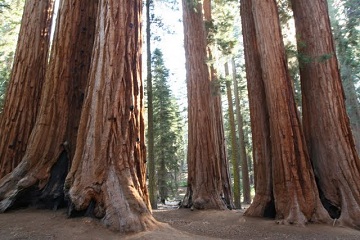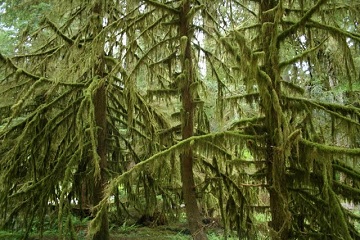- Old-growth forest ecology -
Forests are the major component of terrestrial ecosystems; therefore the need to conserve them is vital. Old-growth forests (ancient forests, Antos & Parish 2002; Antos et al 2005) play a particularly irreplaceable role in maintaining biodiversity and ecosystem services. The research focuses here are on clarifying ecological characteristics of old-growth forests.



Viewing the primeval old-growth forests towering moss covered trees; we can look back into time. Although these forests may seem to last forever due to the trees long life span, these ecosystems never remain forever. Previously it was thought that in order for an ecosystem to be healthy it must have stability, in other words preventing large changes from occurring. For instance, when old trees were killed by typhoons or burned by wildfires, they were often thought of as natural disasters (Mori 2011). However these old-growth forests must have been developing for hundreds and thousands of years after disturbances, and in this long-term succession process, they must have played various ecological roles. There is no doubt that we have to protect old-growth forests from human activities such as deforestation. However, trying to conserve these old-growth forests in a certain state ignores natural dynamics. This may also yield unintended negative outcomes in forest ecosystems.
For this reason, it is necessary to elucidate how old-growth forest ecosystems which at once seemed stable are actually changing. In order to see how these forests will react to a changing environment one has to understand the dynamic nature of old-growth forests. In detail, research outcomes in old-growth forest systems were on tree growth (Mori & Takeda 2003a, 2003b, 2004a, 2004c; Mori & Komiyama 2008; Ishii et al. 2009; Doi et al. 2008a, 2008b), species coexistence (Mori & Takeda 2004b; Mori et al. 2008), and the effect of past disturbances on ecological processes (Mori & Takeda 2004b, Mori et al. 2007). From these results, the dynamic natures of old-growth forests, which seem like a stable system at glance, have been clarified, supporting the non-equilibrium concept of ecology (Mori 2011).

References
Antos JA & Parish R (2002) Structure and dynamics of a nearly steady-state subalpine forest in south-central British Columbia, Canada. Oecologia 130: 126-135.
Antos JA et al. (2005) The tree seedling bank in an ancient montane forest: stress tolerators in a productive habitat. Journal of Ecology 93: 536-543.
Doi Y, Mori AS, Takeda H. (2008b) Effects of stem burial on seedling age determination for Abies mariesii and Abies veitchii in an old-growth subalpine forest in central Japan. Journal of Forest Research 13: 190-195.
Doi Y, Mori AS, Takeda H. (2008a) Conifer establishment and root architectural responses to forest floor heterogeneity in an old-growth subalpine forest in central Japan. Forest Ecology and Management 255: 1472-1478.
Ishii H, Yoshimura K, Mori A. (2009) Convergence of leaf display and photosynthetic characteristics of understory Abies amabilis and Tsuga heterophylla in an old-growth forest in southwestern Washington State, USA. Tree Physiology 29: 989-998.
Mori AS (2011) Ecosystem management based on natural disturbances: Hierarchical context and non-equilibrium paradigm. Journal of Applied Ecology 48: 280-292.
Mori AS, Fukasawa Y, Takeda H. (2008) Tree mortality and habitat shifts in the regeneration trajectory underneath canopy of an old-growth subalpine forest. Forest Ecology and Management 255: 3758-3767.
Mori AS, Komiyama A. (2008) Differential survival among life-stages contributes to co-dominance of Abies mariesii and Abies veitchii in a subalpine old-growth forest. Journal of Vegetation Science 19: 239-244.
Mori AS, Mizumachi E, Komiyama A. (2007). Roles of disturbance and demographic non-equilibrium in species coexistence, inferred from 25-year dynamics of a late-successional old-growth subalpine forest. Forest Ecology and Management 241: 74-83.
Mori A, Mizumachi E. (2005). Season and substrate effects on the first-year establishment of current-year seedlings of major conifer species in an old-growth subalpine forest in central Japan. Forest Ecology and Management 210: 461-467.
Mori A, Takeda H. (2005). Changes in shoot properties in relation to vertical positions within the crown of mature canopy trees of Abies mariesii and Abies veitchii. Journal of Forest Research 10: 51-55.
Mori A, Mizumachi E, Osono T, Doi Y. (2004). Substrate-associated seedling recruiment and establishment of major conifer species in an old-growth subalpine forest in central Japan. Forest Ecology and Management 196: 287-297.
Mori A, Takeda H. (2004c). Functional relationships between crown morphology and within-crown characteristics of understory saplings of three codominant conifers in a subalpine forest in central Japan. Tree Physiology 24: 661-670.
Mori A, Takeda H. (2004b). Effects of undisturbed canopy structure on population structure and species coexistence in an old-growth subalpine forest in central Japan. Forest Ecology and Management 200: 89-100.
Mori A, Takeda H. (2004a). Effects of mixedwood canopies on conifer advance regeneration in a subalpine old-growth forest in central Japan. Écoscience 11: 36-44.
Mori A, Takeda H. (2003b) Light-related competitive effects of overstory trees on the understory conifer saplings in a subalpine forest. Journal of Forest Research 8: 163-169.
Mori A, Takeda H. (2003a) Architecture and neighborhood competition of understorey saplings in a subalpine forest in central Japan. Écoscience 10: 217-224.